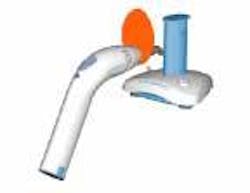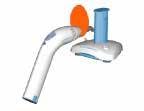Curing light conversations
Michael Miller, DDS
Have you tested the L.E. Demetron I (SDS.Kerr) and/or the Ultra-Lume LED 5 (Ultradent)? Will they cure direct and indirect restorations adequately? Can you recommend them? Since they are a narrower spectrum than halogens, what is the base level power in mW/cm2 that is necessary for adequate curing?
The report on the L.E. Demetron I (pictured at right) was published in the June issue of REALITY NOW. Overall, it achieved very good results in our tests. The Ultralume 5 is currently under evaluation, with preliminary results suggesting it exceeds the performance of its Ultra-Lume 2 brethren. The real question mark with LEDs is not necessarily power, but whether they can cure all materials. None of the LEDs we have thoroughly tested so far can do this, but the preliminary results with the Ultra-Lume LED 5 (pictured below) are promising in this regard.
There is no established minimum power standard for any lights, but we would be suspicious of any light performing below 200mW/cm2 as measured on our industrial light meter from International Light.
You have stated that Build-It FR (Pentron) could be bonded adequately using Prime & Bond NT Dual Cure (Dentsply Caulk). I just received a copy of CRA that states this is one of the materials that has unacceptable bond strength. In the 2003 annual edition of REALITY, OptiBond Solo Plus (SDS Kerr) was used as the adhesive in your core materials bond strength tests. Was this the single-component adhesive or the dual cure?
OptiBond Solo Plus is our standard adhesive for light-cured-only procedures. However, for the 2003 annual edition, we also used it for dual-cure procedures. The single-component adhesive was used, without mixing it with the activator, which we identified as not being effective. For the most part, our 2003 results found dual-cure materials do not require — nor is its performance enhanced by using — dual-cure adhesives. As long as the core is no thicker than 5 mm, cure the adhesive prior to placing the core material. After you light-activate the core, a single-component adhesive should work just fine. This is a significant finding, since it allows us to simplify the placement of cores. As far as CRA stating that Prime & Bond NT Dual Cure has unacceptable bond strength, the dual-cure version did not perform as well in our 2003 tests as it did in 2002. We are not exactly sure why its performance decreased, but the results speak for themselves. Nevertheless, we cannot say this lower performance is unacceptable, since the bond strength to retain a core has not been established.
In your book, you recommend placing the flowable composite in the gingival box, but without extending the material to the margin — the reason being that a highly filled hybrid would be more wear resistant. However, one of the reasons why many dentists like flowables is that they adapt to the cavity more easily. This can be difficult with a packable, rather stiff composite. If you place the flowable in a very thin layer to the margin, wouldn't it be easier to obtain a marginal seal/better integrity than trying to keep it free of the margins, then having to fight to get a proper seal with the hybrid?
I'm not sure where in our book, or even which of our two books, we recommend not extending the flowable to the margin, but this is exactly the opposite of what we show throughout the section on Direct Restorations — Class I & II in The Techniques. We believe the flowable should, indeed, extend to the margin and fill in all the irregularities that would be difficult to accomplish with a thicker material. Nevertheless, depending on the thixotropic nature of a sculptable/packable composite, it is possible to get it to also flow into these same marginal irregularities, although not with the ease of a flowable.
Can you give me a recommendation for a good luting cement for PFM and gold crowns? I've been using Bisco C+B, but I want to change because it is radiolucent. Also, with subgingival preps, bleeding sometimes starts in the subgingival areas after I apply A+B primer. I have read the latest information in REALITY about luting cements and am still a little confused. I am considering a resin-reinforced glass ionomer such as Fuji PLUS (GC America) hand-mixed or FujiCEM (GC America) paste/paste, but am not sure which one to choose. Is there any other luting cement to consider, e.g. resin?
It is difficult to beat the resin ionomers when it comes to luting metal-based restorations. For hand-mixed, FujiCEM is much easier than Fuji PLUS, but Fuji PLUS comes encapsulated, which eliminates the spatula, mixing pad, etc. Your other viable choices are the resin cements paired with self-etching primers, such as Panavia F (Kuraray America), although they are still not quite as easy as resin ionomer.
Would you have a recommendation for a desensitizer for use on a crown prep utilizing resin ionomer for the crown seating? I have been using Gluma (Heraeus Kulzer, pictured at right) to desensitize at the prep appointment and then again just after etch during bonding with Bisco C+B resin cement. I will now also be using FujiCEM and would like to desensitize at the prep and maybe also at the crown seat appointment. I am concerned about any possible loss of adhesion, or chemical or physical interactions that may cause sensitivity.
You don't need desensitizer when luting with a resin ionomer such as FujiCEM other than Fuji Conditioner, which is available from GC America "a la carte." Even without the conditioner, you will rarely (if ever) experience sensitivity if you clean the preparation thoroughly of all residual provisional cement and blot the prep with a 2x2 (no air) so that the tooth mimics our moist protocol. If you want to desensitize at the prep appointment, Gluma Desensitizer is fine and will not interfere with bond strength. However, if you use a provisional resin-based cement such as Provilink, you may find it difficult to remove the provisional when it is time to seat the definitive crown.
Dr. Michael Miller is the publisher of REALITY and REALITY Now, the information source for esthetic dentistry. He is an international lecturer and a fellow of the American Academy of Cosmetic Dentistry, as well as a founding member. He maintains a private practice in Houston. For more information on REALITY and to receive a complimentary issue of his monthly update, REALITY Now, call (800) 544-4999 or visit www.realityesthetics.com.
Looking for more information on the companies mentioned?
Bisco www.bisco.com
Dentsply Caulk www.caulk.com
GC America www.gcamerica.com
Heraeus Kulzer www.kulzer.com
Kuraray America www.kurarayamerica.com
Pentron www.pentron.com
SDS Kerr www.kerrdental.com
Ultradent www.ultradent.com



